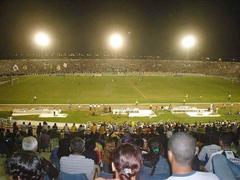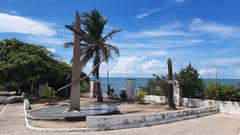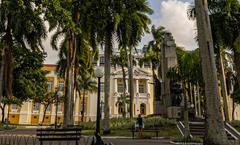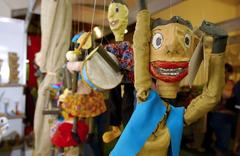
Church Of Saint Francis And Convent Of Saint Antony And Chapel Of The Third Order
Visiting the Church of Saint Francis and Nearby Historical Sites in João Pessoa, Brazil
Date: 04/07/2025
Introduction
In the heart of João Pessoa, Brazil, the Church of Saint Francis (Igreja de São Francisco), the Convent of Saint Antony (Convento de Santo Antônio), and the Chapel of the Third Order (Capela da Ordem Terceira) form a Baroque architectural ensemble that stands as a testament to the city’s colonial past and religious heritage. Established in 1589 by the Franciscan Order during the period of Portuguese colonization, this complex is among the most significant and best-preserved examples of Brazilian colonial Baroque architecture, seamlessly blending Portuguese, indigenous, and African artistic traditions.
Over more than four centuries, these structures have played vital roles in the spiritual, social, and educational life of João Pessoa. Today, they serve as a cultural and artistic hub, hosting exhibitions, concerts, and community events. This guide offers a detailed overview of their history, architectural features, visitor information, and practical tips for exploring João Pessoa’s most celebrated historical site (Wikidata; Bahia.ws; Minhajoaopessoa.com.br).
Origins and Historical Development
Foundation and Early Years
The complex was initiated by Franciscan friars in 1589 with the aim of evangelizing indigenous populations and establishing a strong spiritual presence in the then Cidade Real de Nossa Senhora das Neves (now João Pessoa). The first structures were modest, but by the early 17th century, construction began on more ambitious stone and lime buildings positioned above the Sanhauá River, symbolizing the Franciscans’ religious and social influence (Bahia.ws).
Growth and Flourishing
Major construction and artistic embellishment took place between the 17th and 18th centuries. The church and convent were completed in 1770, and the grand Baroque façade was finalized in 1779. The ensemble expanded to include several chapels, the Golden Chapel (Capela Dourada), a cloister, and a large churchyard, embodying the Franciscan tradition of integrating sacred and communal spaces (Guia Melhores Destinos).
Roles Across the Centuries
Beyond its religious functions, the complex has served as a center for education, charity, and community engagement. It provided schooling for indigenous and Afro-Brazilian children, medical aid, and shelter for the needy. During the 19th and early 20th centuries, the buildings were repurposed as a military hospital and a seamen’s school before being restored for religious and cultural uses in the late 20th century (Ecoturismoecultura.com).
Architectural and Artistic Significance
Layout and Urban Integration
Strategically situated in João Pessoa’s historic center, the ensemble reflects the Franciscan approach of placing religious buildings in urban focal points. The church’s imposing façade faces the city, while the convent’s cloister opens to the natural landscape, embodying ideals of contemplation and harmony with nature. The transformation of the churchyard into a public square (Largo) facilitated both religious processions and civic gatherings (Bahia.ws).
Distinctive Features
- Façade and Bell Tower: The church’s Baroque façade is adorned with intricate stonework, volutes, and a central pediment featuring Franciscan symbols. The single bell tower, topped by a metal rooster, is a city landmark and symbol of vigilance (Ecoturismoecultura.com).
- Azulejos and Gilded Woodwork: The interiors showcase exquisite Portuguese azulejos (blue and white ceramic tiles) with biblical scenes, and talha dourada (gilded woodwork) decorating altars and chapels.
- Ceiling Paintings: Vivid ceiling panels illustrate episodes from the life of Saint Francis of Assisi and other religious narratives.
- Golden Chapel (Capela Dourada): Renowned for its lavish gold-covered carvings, helix columns, and ceiling rosette, this chapel is considered a Baroque masterpiece (Wikipedia).
Cultural and Religious Importance
The complex has been a center for religious, educational, and charitable activities since its foundation, supporting the spiritual and social development of João Pessoa. The Chapel of the Third Order highlights the influence of lay brotherhoods in colonial Brazil, while ongoing festivals, such as the Feast of Saint Francis, continue to foster community spirit (Minhajoaopessoa.com.br).
Visiting the Church of Saint Francis: Hours, Tickets, and Tips
Visiting Hours
- Tuesday to Saturday: 9:00 AM – 4:00 PM
- Sunday: 9:00 AM – 3:00 PM
- Closed on Mondays
- Last entry: 15 minutes before closing
Ticket Prices
- Adults: R$12
- Seniors and children (8–12): R$6
- Children under 8: Free
All proceeds support preservation and maintenance (Guia Melhores Destinos).
Guided Tours
Guided tours are highly recommended for a deeper understanding of the art and history. Tours are mostly in Portuguese, though English and Spanish tours may be available during peak times. Booking in advance is advised for groups (WhichMuseum).
Accessibility
The site provides wheelchair access to key areas, including the main church nave and museum, though some historical sections have uneven floors or stairs. Visitors with limited mobility are encouraged to contact the administration ahead of time for assistance.
Visitor Tips
- Wear comfortable shoes due to cobblestone surfaces and extensive grounds.
- Modest attire is recommended as the complex remains an active religious site.
- Photography without flash is generally allowed; avoid using tripods unless permitted.
- Combine your visit with nearby historical attractions in João Pessoa’s city center (Brazil City Guides).
Highlights and Not-to-Miss Features
- Golden Chapel (Capela Dourada): Marvel at the gold-covered woodwork and ornate altar.
- Cloister and Azulejos: Explore the tranquil arcaded cloisters and blue-and-white tile panels.
- Ceiling Paintings: Admire the church nave’s intricate biblical scenes.
- Sacristy: See the unique myrrh floor and sacred art collection.
Preservation and Community Role
The Church of Saint Francis complex is protected as a national heritage site by IPHAN and houses institutions like the Museum of Sacred Art and Escola de Teatro Piollin, promoting cultural education and community engagement (Minhajoaopessoa.com.br). The site regularly hosts concerts, art exhibitions, and religious festivals, ensuring its ongoing relevance in city life.
Frequently Asked Questions (FAQ)
Q: What are the visiting hours?
A: Tuesday to Saturday, 9:00 AM–4:00 PM; Sunday, 9:00 AM–3:00 PM; closed Mondays.
Q: How much are tickets?
A: R$12 for adults, R$6 for seniors and children 8–12, free for children under 8.
Q: Are guided tours available in English?
A: Primarily in Portuguese, with some availability in English/Spanish during high season.
Q: Is the site accessible to people with disabilities?
A: Most main areas are accessible, though some historic sections may present challenges.
Q: Can I take photos inside?
A: Photography without flash is generally permitted.
Summary and Recommendations
The Church of Saint Francis, the Convent of Saint Antony, and the Chapel of the Third Order stand as extraordinary examples of Brazilian Baroque architecture and living symbols of João Pessoa’s colonial and spiritual history. Their art-laden interiors, historical azulejo panels, and gilded altars offer visitors a rare glimpse into centuries of sacred artistry and cultural evolution. Managed as the São Francisco Cultural Centre, the complex seamlessly integrates preservation and community engagement through exhibitions, festivals, and ongoing educational programming.
For travelers seeking a profound cultural experience, this ensemble is an unmissable destination. Plan your visit by consulting official websites or downloading the Audiala app for up-to-date information, guided tours, and event listings.
Sources and Further Reading
- Wikidata
- Conventos e Igrejas Franciscanas no Período Colonial – Bahia.ws
- História do Centro Cultural São Francisco em João Pessoa – Bahia.ws
- São Francisco Cultural Centre – Minhajoaopessoa.com.br
- Guia Melhores Destinos: Centro Cultural São Francisco
- Ecoturismo e Cultura: What to Do in João Pessoa
- Wikipedia: São Francisco Cultural Center
- WildTrips: João Pessoa Brazil - What to Visit
- WhichMuseum: Church of San Francisco João Pessoa
- Brazil City Guides: João Pessoa Travel Guide





